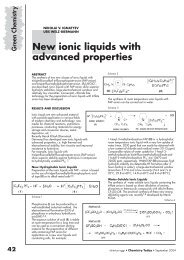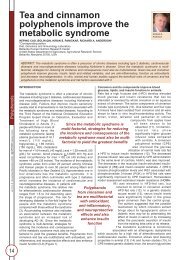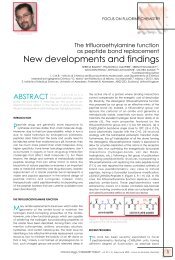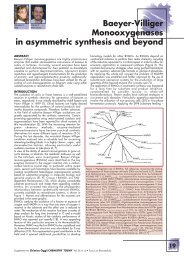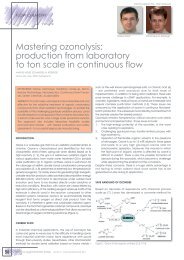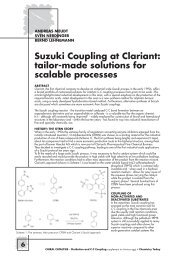Lake Como 2|4 October 2011 - CHIMICA Oggi/Chemistry Today
Lake Como 2|4 October 2011 - CHIMICA Oggi/Chemistry Today
Lake Como 2|4 October 2011 - CHIMICA Oggi/Chemistry Today
You also want an ePaper? Increase the reach of your titles
YUMPU automatically turns print PDFs into web optimized ePapers that Google loves.
Scalable in situ diazomethane generation in continuous-fl ow reactors<br />
Emiliano Rossi a , Pierre Woehl b , Michele Maggini a<br />
a Dipartimento di Scienze Chimiche dell’Università degli Studi di Padova, Via Marzolo 1, 35131, Padova, Italy<br />
b Corning European Technology Center, 7-bis Avenue de Valvins, 77210, Avon, France<br />
Diazomethane is a highly reactive and selective reagent for the synthesis of pharmaceuticals and fine chemicals (1).<br />
However, its acute toxicity and explosive characteristics strongly discourage a large-scale use in synthesis.<br />
In this communication we report an optimized continuous generation of diazomethane through the base-induced<br />
decomposition of the precursor N-methyl-N-nitrosourea which is safer to store than other diazomethane precursors. Process<br />
scale-up was quickly and efficiently achieved on a modular continuous-flow platform that allowed the production and use<br />
of diazomethane up to 19 mol d -1 at a total flow rate of 53 ml min -1 , while maintaining the amount of diazomethane itself in<br />
the reactor limited to 6.5 mmol.<br />
POSTER POSTER POSTER POSTER POSTER POSTER POSTER POSTER POSTER POSTER POSTER POSTER POSTER POSTER POSTER POSTER POSTER POSTER POSTER POSTER POSTER POSTER POSTER POSTER POSTER POSTER POSTER POSTER POSTER POSTER POSTER POSTER POSTER POSTER POSTER POSTER POSTER POSTER POSTER POSTER POSTER POSTER POSTER POSTER<br />
1<br />
Microstructured glass reactors and LED illumination: photochemistry as good as it can get<br />
Simone Silvestrini, Christian Corrado De Filippo, Tommaso Carofi glio, Michele Maggini<br />
Dipartimento di Scienze Chimiche, Università di Padova, via Marzolo 1, 35131 Padova (PD) Italy<br />
Light emitting diodes (LEDs) are interesting cold light sources with very high power conversion (80-90%) and narrow<br />
emission bands. They find application in consumer electronic devices and lighting. LED light has only found limited use in<br />
photochemistry because of the difficulty to obtain low-cost diodes that emit in the deep UV region. However, since new<br />
materials for LED applications is rapidly filling this gap, LED-driven photochemistry has the potential to become an important<br />
tool to access selective and efficient chemical syntheses.<br />
In this presentation we show how organic photochemists and material scientists can benefit from LEDs through the use of<br />
microstructured glass reactors. To this end, we present two examples that best encompass the most interesting features of<br />
LED illumination: (i) low power consumption, resulting in economical and environmental friendly processes and (ii) narrow<br />
emission bands, resulting in highly selective reaction paths.<br />
(i) Low-power commercial white LED arrays can be used for the quantitative conversion<br />
of reagents in photocycloadditions thanks to their high efficiency and the optimal<br />
geometry of glass microreactors. The reduced thickness of the microfluidic channel,<br />
ensures a uniform illumination of the reaction mixture, reduced reaction times and high<br />
space time yields.<br />
POSTER POSTER POSTER POSTER POSTER POSTER POSTER POSTER POSTER POSTER POSTER POSTER POSTER POSTER POSTER POSTER POSTER POSTER POSTER POSTER POSTER POSTER POSTER POSTER POSTER POSTER POSTER POSTER POSTER POSTER POSTER POSTER POSTER POSTER POSTER POSTER POSTER POSTER POSTER POSTER POSTER POSTER<br />
2<br />
This process productivity could, at least in principle, fulfill the needs of small pharma or<br />
fine chemical companies. Best reaction parameters were first developed on a smallvolume<br />
flow reactor (0.9-1.35 ml) for minimal reagents consumption.<br />
Then a 10-folds production improvement was achieved by increasing the flow reactor<br />
dimensions (15-25 ml) with a very limited optimization effort.<br />
(1) G. Maas, Angew. Chem. Int. Ed., 48, 2009, 8186.<br />
(ii) Illumination of small (3 nm) silver nanoparticles (AgNPs) results in a growth along<br />
preferential directions, depending on the wavelength of the radiation. This effect can<br />
be used to produce AgNPs with specific shapes and plasmonic properties that depend<br />
on the excitation wavelength used. In this case, microfluidic reactors allow to quickly<br />
produce AgNPs that can be functionalized with thiols or used immediately for surface<br />
enhanced raman spectroscopy (SERS) analysis.<br />
23<br />
<strong>Lake</strong> <strong>Como</strong><br />
<strong>2|4</strong> <strong>October</strong> <strong>2011</strong>



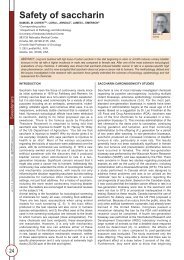
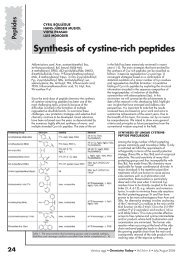
![Pietro Delogu [modalità compatibilità]](https://img.yumpu.com/12255149/1/190x135/pietro-delogu-modalita-compatibilita.jpg?quality=85)
